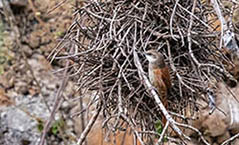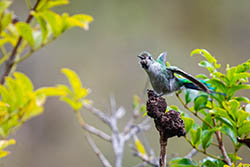Photos with this report (click to enlarge) | |||
 Chestnut-backed Thornbird |
 Grey-bellied Comet |
||
A client requested Green Tours Peru a very specific list of Peruvian endemics from northern Peru before leaving back to his home country. Some of the species are no easy to find so we needed to make a pre-trip to scout the area and try to find the best spots to see these species. The species he requested are:
1. Great Spinetail
2. Buff-bridled Inca-Finch
3. Grey-bellied Comet
4. Plain-tailed Warbling-Finch
5. Rufous-breasted Warbling-Finch
6. Unicolored Tapaculo
7. Chestnut-backed Thornbird
8. Grey-winged Inca-Finch
9. Yellow-faced Parrotlet
10. Purple-throated Sunangel
11. Russet-backed Softtail
12. Neblina Tapaculo
13. Coppery Metaltail
14. Large-footed Tapaculo
15. Rufous-breasted Antpitta (leymebamba sub-species)
16. Rainbow Starflontlet
17. Unstreaked Tit-Tyrant
18. Pale-billed Antpitta
19. Rusty-tinged Antpitta
A few of these are not easy to find or see (some might be common and very vocal, but quite shy and difficult to see!):
1. Great Spinetail
2. Plain-tailed Warbling-Finch
3. Rufous-breasted Warbling-Finch
4. Unicolored Tapaculo
5. Chestnut-backed Thornbird
6. Grey-winged Inca-Finch
7. Large-footed Tapaculo
8. Rufous-breasted Antpitta, and
9. Unstreaked Tit-Tyrant
So, the main objective of the trip was to find a good way to actually "see" these 9 difficult species.
Itinerary:
Day 1. June 28 2018.
This morning we visited the Abra Gavilán area, near the city of Cajamarca, looking for Unicolored Tapaculo. We scouted a couple of creeks after the pass and hear a couple of birds singing but we were not able to see them, so we decided to drive a little bit more than the road on the western side of the pass. At out first stop we heard a bird calling in a creek that allowed access very close to the bushes. We entered the bushes, sat on the ground, and start calling the bird. A male responded very quickly, and got very close to us, even above our heads, it was so close and their moves so fast that we were not able to take any pictures !
With our mission accomplished, we start to drive back to the city, but we decided to make another stop at another location that looked promising, and yes, this time we had a female Unicolored Tapaculo just in front of us, we didn't even had to use playback, the bird showed all by itself. But once again, we couldn't take any pictures, this time we were surprised by the bird, didn't expect it to be there in the open.
Our next target for the day was Great Spinetail. The classic site for the species near Cajamarca is a dry creek near the town of San Marcos, but we were told by a friend that near the town of Jesus the bird was showing very well. So we took the road for about 40 minutes from the city of Cajamarca and found the site very easily just past the town. It's a small patch of Acacia, and finding the birds was not difficult at all. As soon as we jumped out of the car, we heard a couple of birds calling in the bushes and showing very well. We didn't have to use the playback. Also, Buff-bridled Inca-Finches are quite common in the area.
Day 2. June 29 2018.
Early in the morning we went to the Chonta valley, the site for Grey-bellied Comet, the bird is quite common and we did not had any problem in finding it as soon as we arrived in the area. But our targets here were a couple of more difficult species to find: Plain-tailed and Rufous-breasted Warbling-Finches. After walking the valley and explore a couple of nearby creeks for about three hours, we end-up finding a pair of Plain-tailed Warbling-Finches near the narrowest part of the canyon. Unfortunately we fail finding the Rufous-breasted Warbling-Finch.
Then we stopped our scouting for a few days, and restarted on July 14 in the Marañon valley and Leymebamba area.
Day 3. July 14 2018.
We left Cajamarca at 05:00 in the morning and drove for two and a half hours to the site of El Limón, in the Marañon valley. Grey-winged Inca-Finches showed up very quickly, but we only heard a very distant Chestnut-backed Thornbird. Then we explored another narrow valley near El Limón, called El Utco. Here, the thornbirds were very vocal and seemed to be quite common, and after an hour or so, we could find a bird building its nest. We also had a couple of Grey-winged Inca-Finches flying and singing very close to us.
Then, we continued our way down towards the Marañon river looking for Yellow-faced Parrotlets, but couldn't see any this time.
After crossing the river we took the road up the mountains to look for our target hummingbirds and Tapaculos. The first stops were to look for Purple-throated Sunangle, we couldn't see any but we had a good view of a Russet-backed Softail and a Blackish Tapaculo. Near the Abra Barro Negro (calla Calla) pass we had good views of Neblina Tapaculo.
After the pass we started our descent to the Leymebamba valley. Along the road we heard several Large-footed Tapaculos and Rufous-breasted Antpittas, but none of them came out into the open for us to see. Large-footed Tapaculo showed up at an elevation of around 3000 meters, where we found an opening in the bushes, and the bird responded to the playback quite easily. We saw the Rufous-breasted Antpitta in the lowest part of the road, almost at the valley. Here again, we found an opening in the bushes that allowed us to get inside the bushes and stay under cover, after some ten minutes of playback an Antpitta finally showed up, not too close but we had clear views of the bird.
With today's mission accomplished, we drove down the valley to the town of Leymebamba for the overnight.
Day 4. July 15 2018.
With only two species left to find for this trip, we started our day very early visiting the Atuen valley, near the town of Leymebamba. Our targets today were Purple-throated Sunangel and Unstreaked Tit-Tyrant. We had bad weather this morning, it was very cold, and the birds were not very active. During the few minutes of sunshine we had Citrine Warblers, Grey-breasted Mountain-Toucans, a Masked Trogon, a flock of Capped Conebills, a Pearled Treerunner, and a Sharp-shinned Hawk flying above us; but no sing of any Sunangel nor a Tit-Tyrant during the whole morning.
In the afternoon we drove for about three ours to our next stop in the town of Pomacochas, planning to explore the San Lorenzo area the next morning for a last chance for the Unstreaked Tit-Tyrant.
Day 5. July 16 2018
Last day of the trip before returning home, and last chance for the Tit-Tyrant. The walk up to the San Lorenzo crest is quite steep and took us about one hour to get to the right spot. Once there, the Pale-billed Antpitta was quite easy, but the Unstreaked Tit-Tyrant didn't want to show up today.
Only two of the nine species eluded us during this scouting trip, but we are confident we won't miss them in August when well go back with the clients.